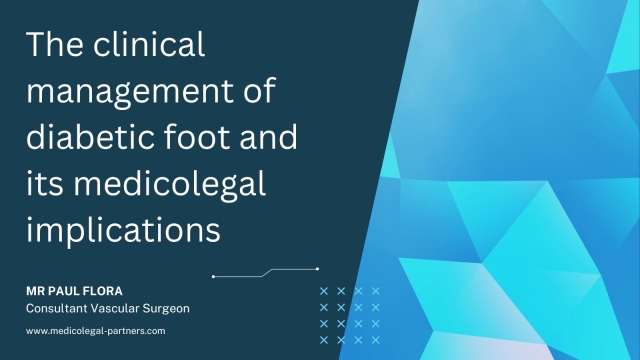A medicolegal perspective on the treatment of varicose veins

Varicose veins are superficial blood vessels, most commonly in the lower extremities, that have become abnormally enlarged and convoluted, normally as a result of defective valves, which allow blood to flow in the reverse direction. They form part of a continuum of chronic venous disease, which ranges from fine telangiectasias (also known as spider veins) through to chronic venous insufficiency. Varicose veins are extremely common, and while estimates of the prevalence vary widely, it is thought that around 15% of men and 30% of women have them. Risk factors include a family history of venous disease, older age, prolonged standing, deep venous thrombosis resulting in damage to the valves and factors, such as pregnancy, obesity, chronic constipation or tumours, that lead to a chronic increase in intra-abdominal pressure.
The clinical presentation of varicose veins can be variable and some patients are completely asymptomatic. Symptoms, which include pain, itching and throbbing at the affected site and more generalised swelling of the leg, are often worse at the end of the day and may resolve when patients sit, especially if the legs are raised. Although often thought of as a purely cosmetic disorder, varicose veins are associated with considerable pain and discomfort and can have a significant socioeconomic impact in terms of absence from work. Furthermore, if left untreated, progression of the underlying disease process can lead to severe complications, including significant skin loss from ulceration.
Initially, conservative options may be considered for the treatment of varicose veins, particularly for patients who are not suitable, or do not wish to receive, more invasive procedures. These include lifestyle modifications, such as weight loss for obese patients, avoiding prolonged standing, wearing non-restrictive clothing, exercise and modification of other cardiovascular risk factors. External compression, in the form of support stockings can also be used. However, there is limited evidence of its effectiveness, particularly as the optimal pressure and length of treatment remain unclear, and its use as a first-line treatment is generally restricted to pregnant women. Phlebotonics, usually consisting of oral or topical plant-based compounds, may also be prescribed. These aim to decrease the symptoms of chronic venous insufficiency by increasing venous tone, improving capillary hyperpermeability and decreasing blood viscosity, although long-term data on the safety and efficacy of this type of treatment is limited.
If a conservative approach is unsuccessful, various invasive procedures are available. For years, surgical intervention, involving ligation and stripping of the affected vein was the standard treatment. One advantage of surgery is that it can be performed on blood vessels of any size, location and anatomical complexity. A major drawback of this technique is the recurrence rate: five-year recurrence rates as high as 65% have been reported. While some of these are due to inadequate surgical technique, many arise from disease progression or from the formation of new blood vessels which then become affected themselves. As a result, surgery is being increasingly rejected in favour of alternative minimally invasive treatments, which have lower rates of both relapse and other complications, as well as faster recovery times. These include thermal ablation, in which a laser or radio waves are delivered via an endovenous catheter, to produce heat that coagulates the blood in the vein, which is then destroyed. Although this option carries a small risk of nerve damage due to thermal injury, in most cases this is temporary.
Sclerotherapy uses an ultrasound-guided needle to inject the affected vein with an agent that causes inflammation of the endothelium, which results in fibrosis and eventual occlusion of the vessel. This method is typically used for smaller vessels, but there is no defined cut-off diameter and it is also a useful technique for recurrent varicose veins. Various agents can be used, usually sodium tetradecyl or polidocanol, but there is no evidence that any one is more effective than the others. Overall, this method is less successful than surgery or ablation in terms of maintaining occlusion of the veins and can leave the overlying skin with a brown staining. However, the recovery time is reduced compared to surgical intervention.
Before an interventional treatment is considered, it is important that the vein is properly imaged so that the appropriate treatment technique can be chosen. Ultrasonography is most commonly used, as it can accurately determine both the location and size of incompetent valves and the extent of blood reflux. Other imaging modalities are generally only used if ultrasonography is inconclusive or in more complex cases.
It is also important that patients are aware that all invasive techniques carry a risk of complications, although these are usually fairly minor. Numbness, persistent tenderness, skin discolouration or ulceration, and lumpiness are the commonest complications, occurring in up to 7% of patients. Hematomas are rarer and are usually associated with surgery.
Although rarely associated with major complications themselves, evidence shows that varicose veins can have a significant effect on a patient’s quality of life. Various treatment options are available but there is as yet no reliable algorithm for determining which is the most suitable for each individual patient. Therefore, the choice of treatment must be based instead on the presenting symptoms, results of imaging, expert recommendation and patient preferences.
Further reading:
Chwała, M., Szczeklik, W., Szczeklik, M., Aleksiejew-Kleszczyński, T., & Jagielska-Chwała, M. (2015). Varicose veins of lower extremities, hemodynamics and treatment methods. Advances in Clinical and Experimental Medicine, 24(1), 5–14. https://doi.org/10.17219/acem/31880
Raetz, J., Wilson, M., & Collins, K. (2019). Varicose Veins: Diagnosis and Treatment. American Family Physician, 99(11), 682–688.



